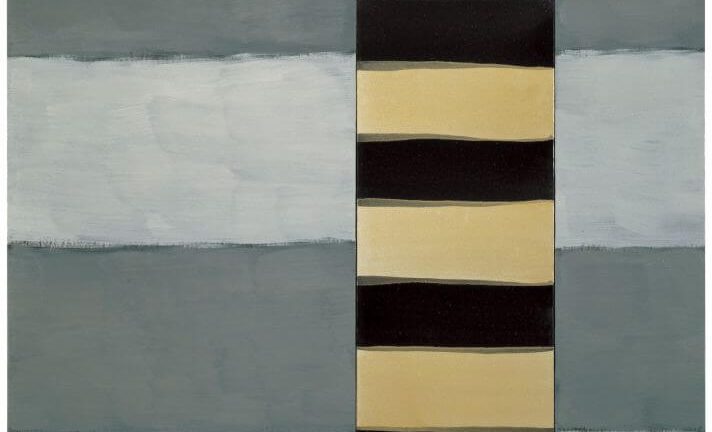Summary
- American-Irish artist Sean Scully is one of the most recognized contemporary painters in the world.
- Although Scully’s work is predominantly abstract, the starting point of his art is the human figure.
- The traveler series describes the importance of travel in his life. These paintings contain another image, an insert, and a passenger.
- The landlines – vertical and horizontal color stripes are his core motif where he explores nature and interpersonal relationships.
Sean Scully was born in 1945 in Ireland and grew up in England in a working-class family in South London. His family lived very poorly, which significantly determined his upbringing. He attended local convent schools and evening school at the Central School of Art in London where he developed an interest in figurative painting. He would stick to it until the end of the 1960s. Scully desired to become an artist: he always thought this was something profound and spiritual. In the early 1970s, he visited the USA for the first time. He was awarded the Frank Knox Fellowship to attend Harvard University and, in 1975, he moved to New York where he became famous and where he lives to this day.
The Importance of Traveling
Travel and emigration are of great importance in Sean Scully’s life. The trips that influenced his works the most are a student trip to Morocco in 1969, a visit to Yugoslavia (especially Fort Lovrijenac in Croatia) a year earlier, a trip to Mexico in 1984, and a visit to the Irish Aran Islands in 2005.
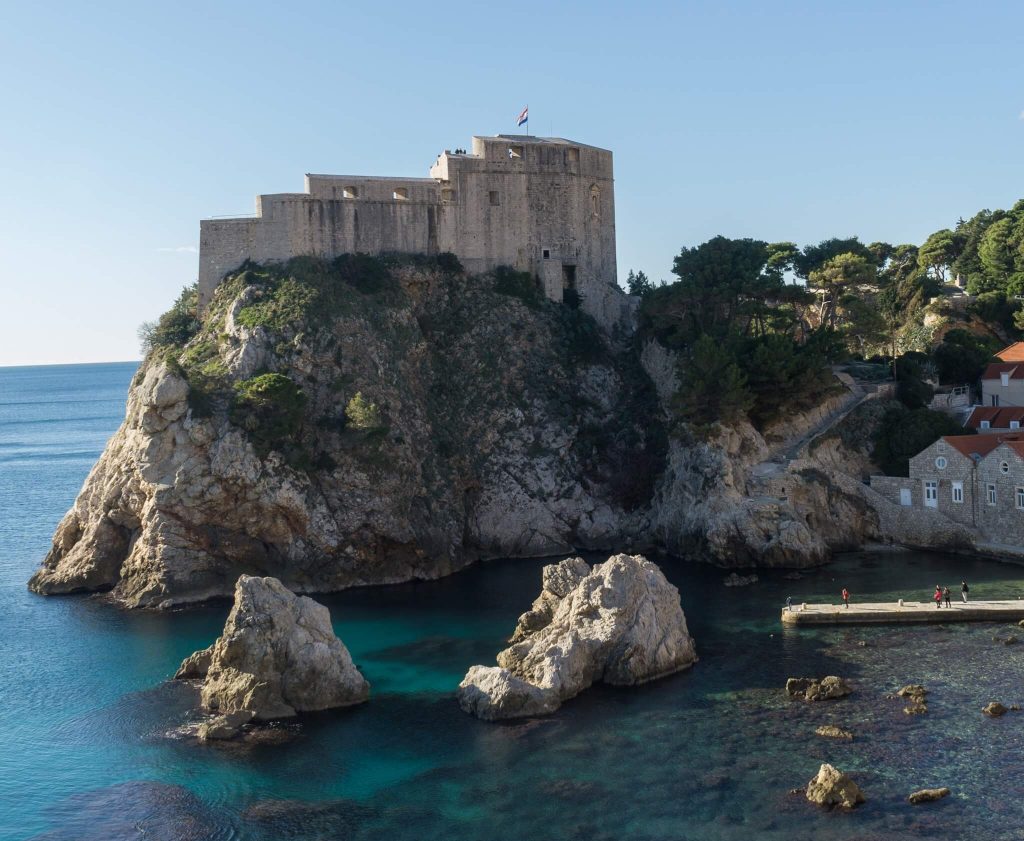
Fort Lovrijenac, Dubrovnik, Croatia. MSU Facebook.
Fort Lovrijenac is located on the top of an impressive rock surrounded by the sea outside the city walls of Dubrovnik in Croatia (former Yugoslavia). Scully’s understanding of sculpture was directly shaped by this building; he thought that the stone itself was the result of objects and materials being compressed over time, like leaves, wood, and earth. The geometric quality of the stone affected his approach toward sculpture-making.
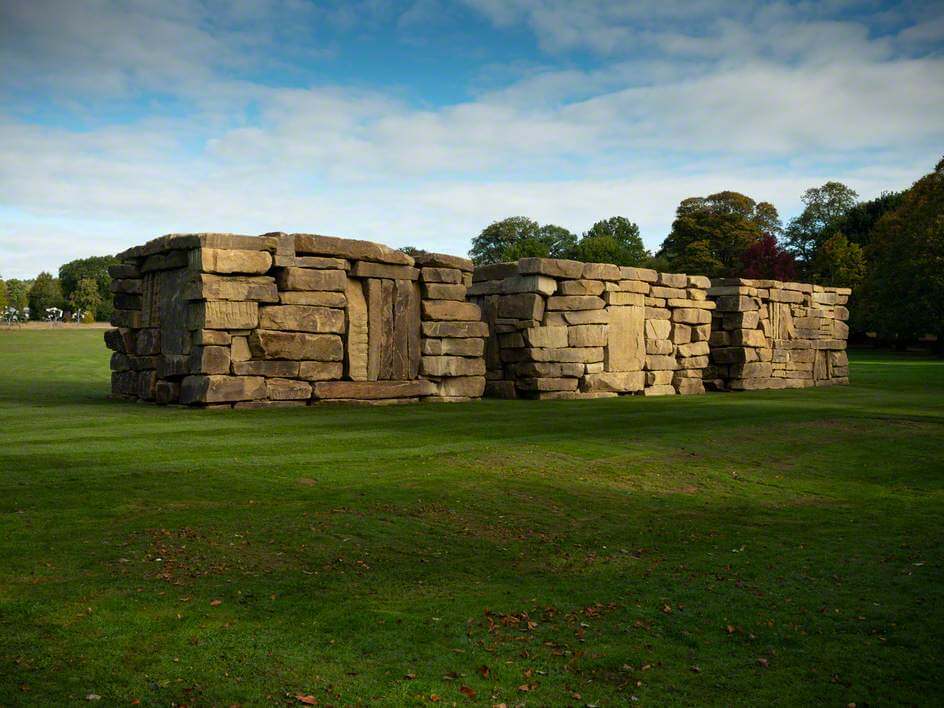
Sean Scully, Wall Dale Cubed, 1945. Photo by Jonty Wilde.
The sculpture Wall Dale Cubed is made from stone sourced from Yorkshire in England. The relationship between the stone and its place of origin is extremely important to Scully. In the blocks of Wall Dale Cubed, the windows and doors all are pushed in and the space is compressed. There is no open space, it is all filled in. This colossal work is constructed the same way throughout, which references ancient stone walls in Ireland.
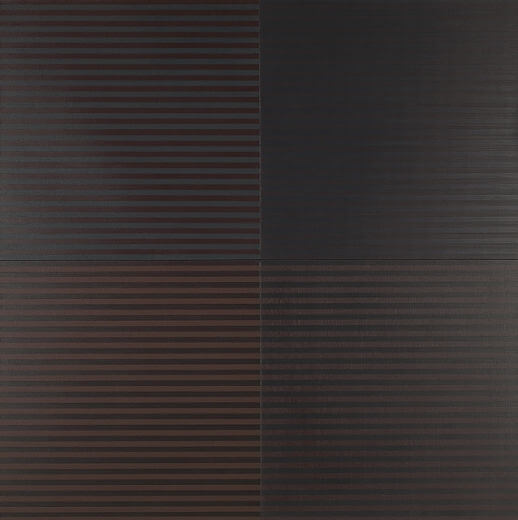
Sean Scully, Fort #3, 1980, private collection. Fine Art Biblo.
Sean assimilated himself into New York by taking on Minimalism which was at its peak in the early 1970s. But even though his paintings are abstract, they are always poetic in some way and in some sense figurative: Fort #3, for example, is based on the idea of a Roman fort.
There Is Always a Story Inside
Although Scully’s work is predominantly abstract, the starting point of his art is a human figure. Each picture keeps a personal story from his life.
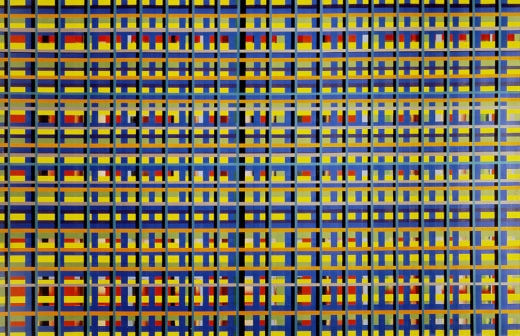
Sean Scully, Backcloth, 1970, private collection. Fine Art Biblio.
Scully worked lots of different jobs, often physically exhausting and mostly in crowded spaces. His artworks are also crowded: all space is filled in, obsessively and systematically. He used the spray gun because he wanted to have a relationship with the proletariat, the working class, and industrial materials. The spray gun returns to his work periodically as he likes the connotations with the street, industry, and with working-class material. He started making grids on canvas, layer upon layer until order made chaos. Scully revealed that he was interested in using order to destroy itself as if Abstract Expressionism were incarcerated.
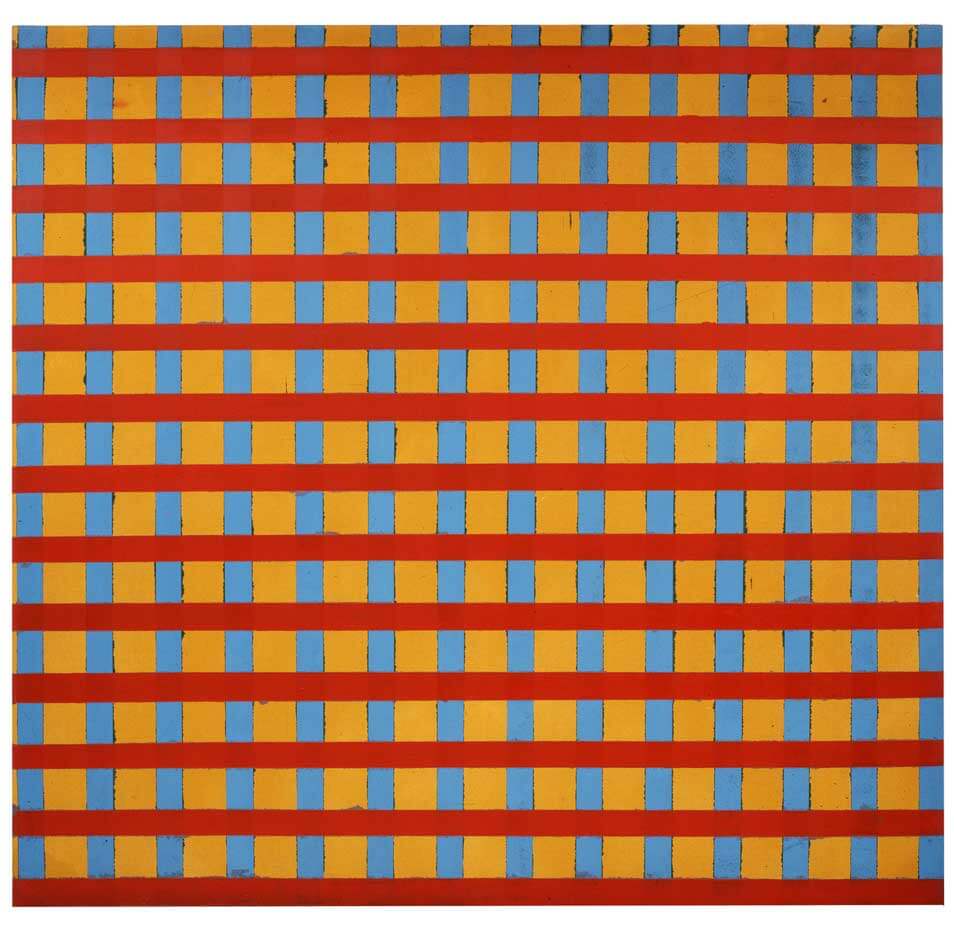
Sean Scully, Crossover painting 1, 1974, private collection. Balkon.
It seems now that the impending invasion of the computer was in the air.
MSU Zagreb, Croatia.
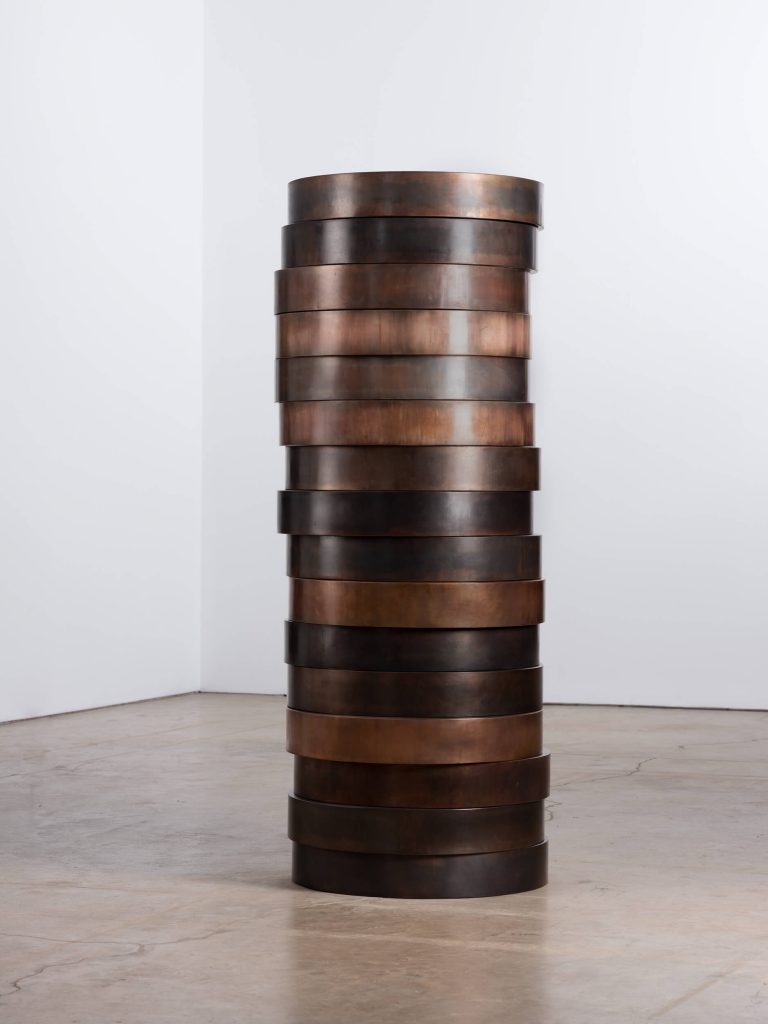
Sean Scully, Coin Stack, 2018. Photo by Stefan Müller.
Sean Scully’s father was a barber and half of his income was from tipping. Each Friday night, his father would make stacks of coins and the rest of the family would watch anxiously; the stacks of coins signified security. Coin Stack is a sculpture of the memory of that story.
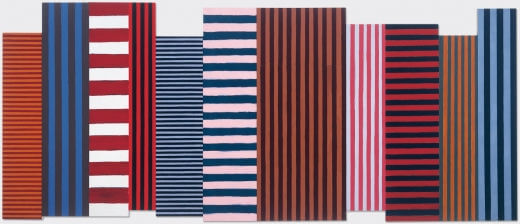
Sean Scully, Backs and Fronts, 1981, private collection. Fine Art Biblo.
Scully achieved world fame when he exhibited Backs and Fronts in New York’s PS1 Museum of Modern Art. The painting consists of 11 panels moving horizontally across the canvas with colored stripes that optically move in different directions as if they were a musical score. The left part of the painting is directly inspired by Picasso’s 1921 painting Three Musicians. During the process, Scully kept adding figures to the right, further expanding the painting. The work was a turning point in his career.
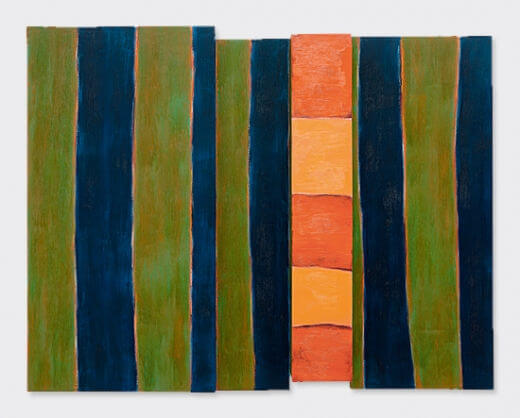
Sean Scully, The Bather, 1983, private collection. Fine Art Biblo.
Many of Scully’s paintings are homages to great artists. The Bather is an homage to Matisse. The colors reference nature (rivers, trees) and the panel with the orange and pink bulge out in the middle, as it was cut off and separated from its environment, can be seen as a figure within an abstract environment.
Windows and Landlines
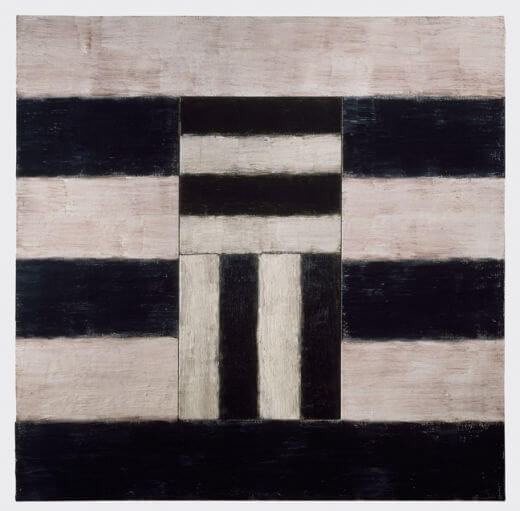
Sean Scully, Empty Heart, 1987, private collection. Fine Art Biblio.
Towards the end of the 1980s, Scully became more interested in the idea of windows and painting in a painting. Scully used to work in the printing industry where he would insert intaglio plates into bodies of metal type. He understood windows as not simply painted, but as an image that is pushed into another painting. Empty Heart was painted for his son who died in 1983. Scully said that there are basically two paintings: the painting of a hole and a painting of what fills that hole. After his son’s death, his works became darker and often colorless.
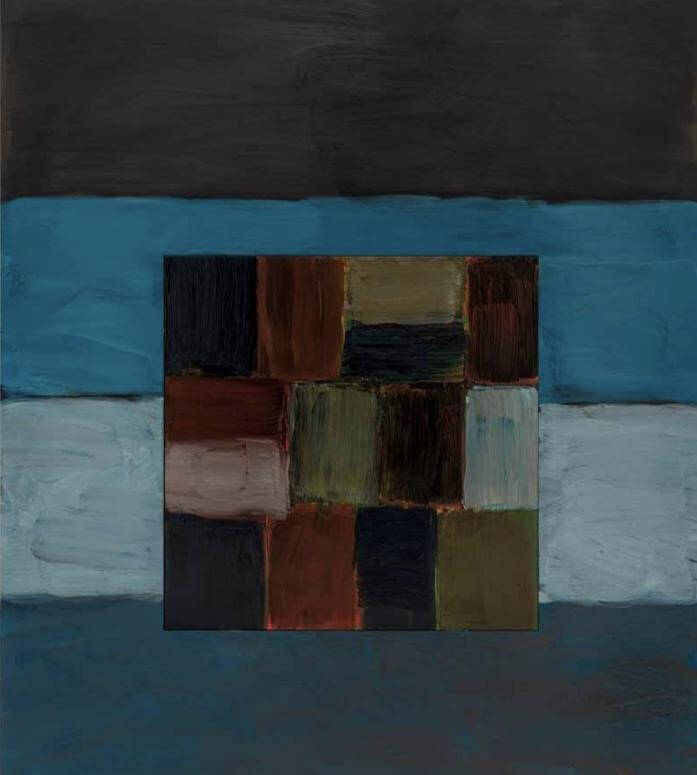
Sean Scully, Wall Landline Pool Dusk, 2022, private collection. Jutarnji list.
Scully said he painted Wall Landline Pool Dusk in the late afternoon because of the beautiful light that was coming into the room at that time. He revealed that dusk actually was his favorite time of the day; it wasn’t day and it wasn’t night. It is a painting inside of a painting. Scully described it as a figure, a metaphor, a discord, or a wall of light inside a landline.
I try to paint this, this sense of the elemental coming-together of land and sea, sky and land, of blocks coming together side by side, stacked in horizon lines endlessly beginning and ending – the way the blocks of the world hug each other and brush up against each other, their weight, their air, their color, and the soft uncertain space between them.
Landline, 2001
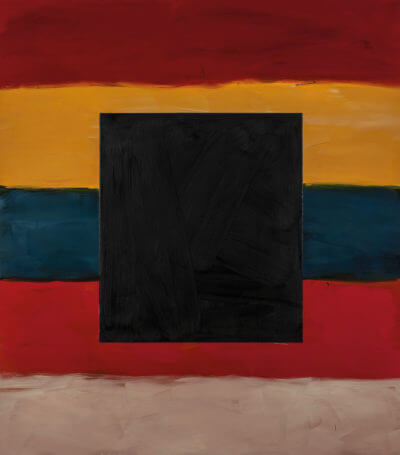
Sean Scully, Black Window 3, 2020. Photo by Christoph Knoch.
The painting with a black window at the center is a reference to Kazimir Malevich’s famous Black Square. Scully painted it during the pandemic. It symbolizes the state that humanity was in at that moment. He put Malevich’s black square in a so-called “Scully landscape,” a window without a view referencing our own state during the pandemic and lockdowns.
Abstraction As a Promotor of Tolerance
Scully believes that there is an abstract rhythmical structure that runs parallel to all life and that unconsciously binds us together. For him, abstraction naturally creates free thought because abstract painting creates flexibility of mind and emotions.
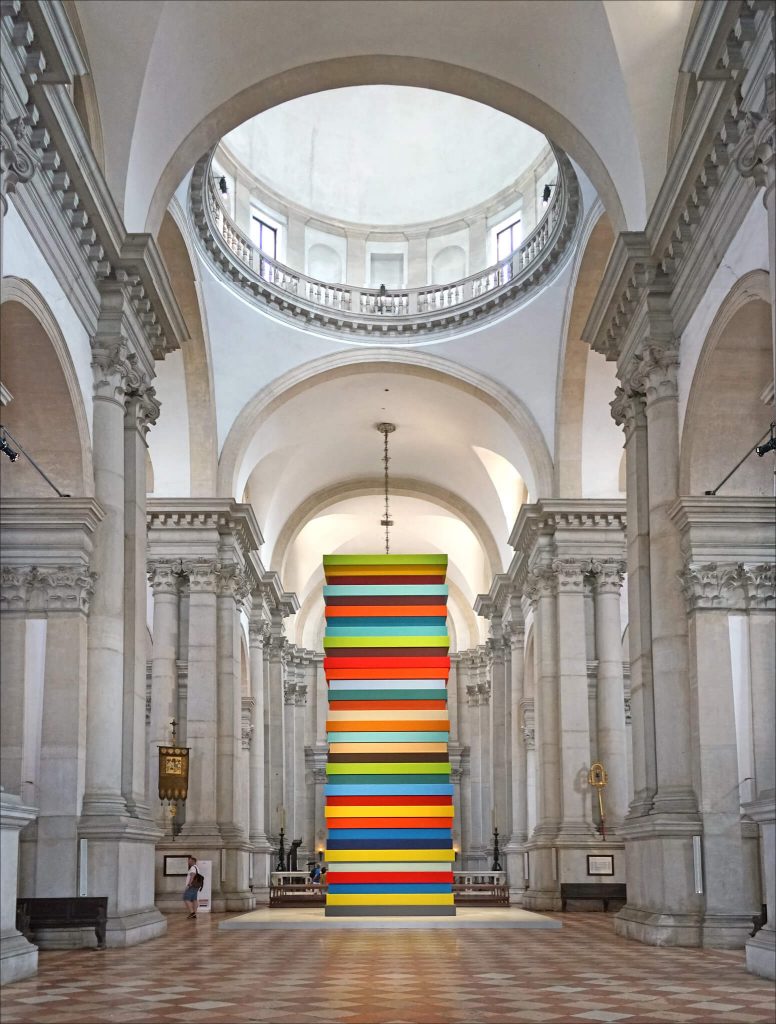
Sean Scully, Opulent Ascension, 2019, Basilica of San Giorgio Maggiore, Venice, Italy. Flickr.
The sculpture Opulent Ascension is made of felt, which takes all the light out of the room. The sculpture is not lit, it lights itself. If you went inside it, it would be like being in a silent chamber because it absorbed the sound, too.
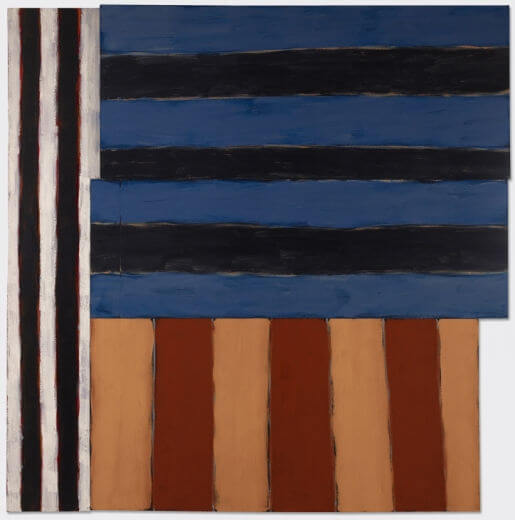
Sean Scully, Blame, 1983, private collection. Fine Art Biblio.
In the play by French philosopher Jean-Paul Sartre called No Exit, three people are trapped in Hell, which is actually a single room. They are locked together for eternity in a dialog of blame. This play inspired Scully for his painting Blame. Here, Scully added panels that actually don’t fit together, symbolizing endless irresolvability. He also thought of them as being portraits of the city of New York, the city of blame and envy, as he explained.

Sean Scully, Arles-Abend-Vincent, 2013, private collection. Fine Art Biblio.
The painting Arles-Abend-Vincent consists of three paintings, all similar, but painted differently. The edges of each painting are different as well as the relationships inside the paintings. Each of the three parts draws out another kind of emotion. There are colors of nature, of the sky, and of the forest. Scully points out that he is not painting a landscape but an abstract painting that yearns to be a landscape. The soft edges are metaphors for how the things in the world come together.
Return to Figuration
Through his work, Scully openly talks about personal traumas. Recently, he returned to figuration to transfer intimate moments (such as the birth of his younger son) to the canvas and document his view of parenthood. So, he made a detour and turned toward figurative painting. After he finished the series of paintings with his son, he returned to abstraction.
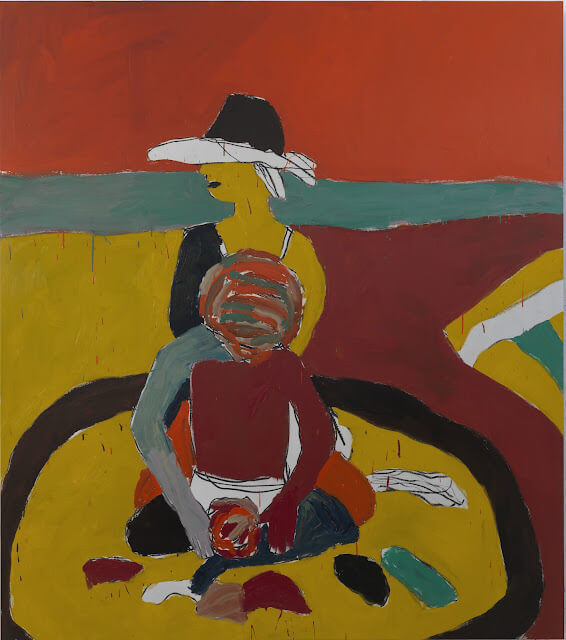
Sean Scully, Madonna 1, 2018, private collection. Photo by Brian Buckley.
For Scully, making photographs of his son didn’t feel like enough. He wanted to do something to stop time. So, he made a series of paintings of his son playing on the beach and his mother behind him. In the painting Madonna 1, the hair of the mother resembles a gun, so she looks like a bodyguard or a bird. The arms of the child are in different colors because they are doing different things.
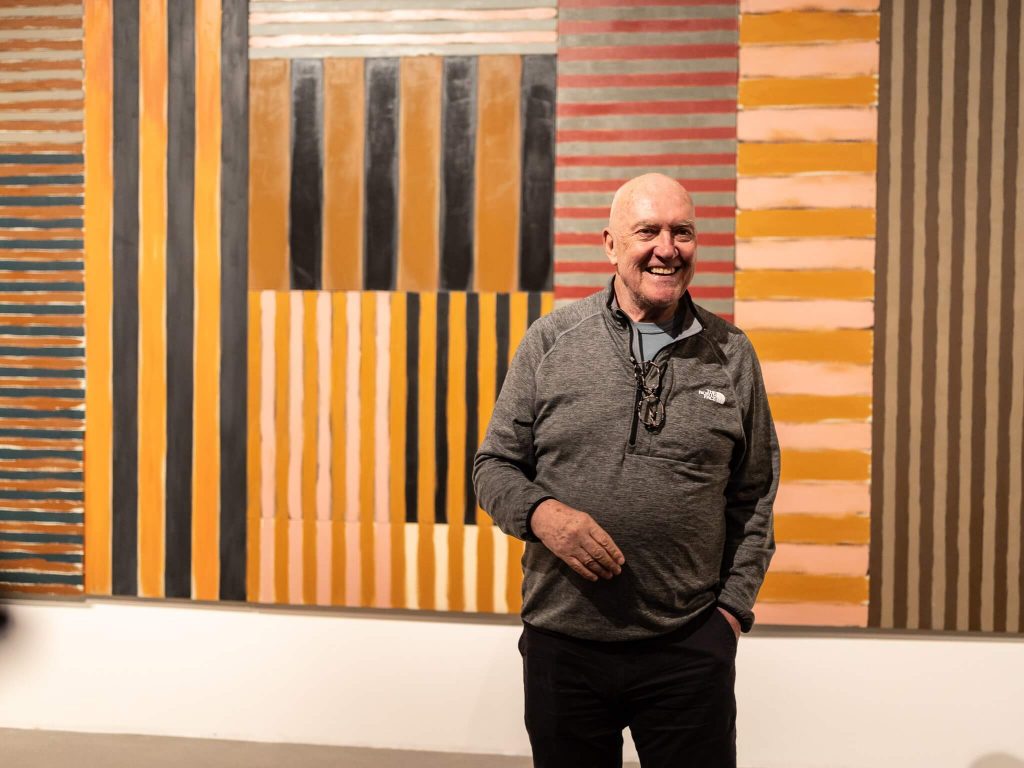
Sean Scully at the Museum of Contemporary Art, Zagreb, Croatia, 2022. MSU.
Although Scully once said that not everything in art had to be understood, he is a great storyteller in his own paintings, especially when he explains his passion for abstraction. We recommend you listen to his lecture or an interview, as the artist talks in a very poetic and personal way about his art.
From November 16, 2022, till March 12, 2023, you can admire 64 canvases, works on paper, photographs, and sculptures from all phases of Sean Scully’s work in the Museum of Contemporary Art in Zagreb. Scully’s Zagreb retrospective entitled Passenger is the final, fourth stop of the artist’s tour that began at the Museum of Fine Arts in Budapest, Hungary, and continued at the Benaki Museum in Athens, Greece, and the Museum of Modern Art in Bologna, Italy (MAMbo).
